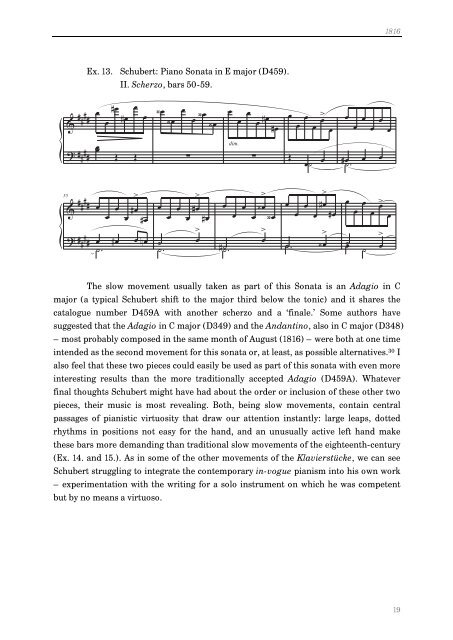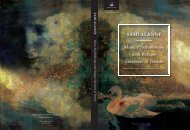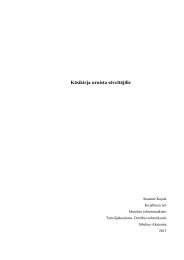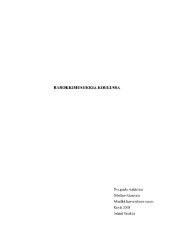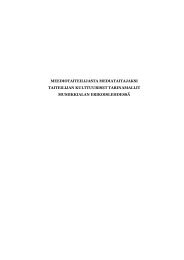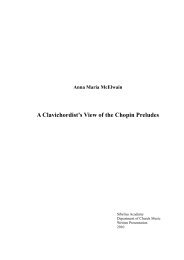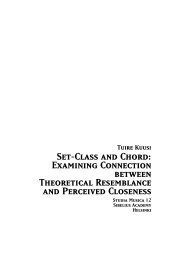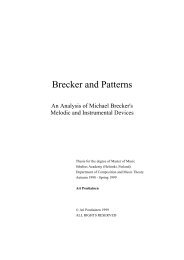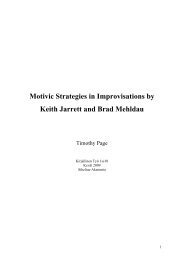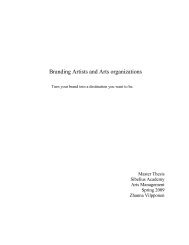The Unfinished Piano Sonatas of Franz Schubert Javier ... - Ethesis
The Unfinished Piano Sonatas of Franz Schubert Javier ... - Ethesis
The Unfinished Piano Sonatas of Franz Schubert Javier ... - Ethesis
Create successful ePaper yourself
Turn your PDF publications into a flip-book with our unique Google optimized e-Paper software.
#<br />
& #<br />
# #<br />
? # #<br />
# #<br />
#<br />
& #<br />
# #<br />
55<br />
? # #<br />
# #<br />
Ex. 13. <strong>Schubert</strong>: <strong>Piano</strong> Sonata in E major (D459).<br />
œ œ<br />
œ<br />
# œ<br />
II. Scherzo, bars 50-59.<br />
# œ<br />
Œ Œ<br />
œ œ<br />
><br />
œ<br />
œ<br />
œ # œ<br />
œ # œ<br />
œ # œ œ n œ<br />
˙ .<br />
‹ œ<br />
‹ œ<br />
œ<br />
œ<br />
‹ œ<br />
∑<br />
><br />
œ<br />
œ<br />
œ # œ<br />
œ # œ<br />
˙<br />
œ ><br />
˙ .<br />
‹ œ<br />
œ œ<br />
œ œ # œ<br />
dim.<br />
∑<br />
# œ<br />
><br />
œ<br />
œ<br />
œ ‹ œ<br />
œ ‹ œ<br />
# ˙ .<br />
><br />
œ<br />
œ œ œ œ œ ><br />
Œ<br />
œ˙<br />
œ<br />
œ<br />
œ<br />
œ<br />
œ # œ<br />
œ ><br />
# œ<br />
˙<br />
‹ œ<br />
><br />
˙ .<br />
œ œ œ œ œ œ<br />
# œ œ œ<br />
˙ .<br />
œ œ œ œ œ ><br />
˙ œ ><br />
œ ˙<br />
1816<br />
<strong>The</strong> slow movement usually taken as part <strong>of</strong> this Sonata is an Adagio in C<br />
major (a typical <strong>Schubert</strong> shift to the major third below the tonic) and it shares the<br />
catalogue number D459A with another scherzo and a ‘finale.’ Some authors have<br />
suggested that the Adagio in C major (D349) and the Andantino, also in C major (D348)<br />
– most probably composed in the same month <strong>of</strong> August (1816) – were both at one time<br />
intended as the second movement for this sonata or, at least, as possible alternatives. 30 I<br />
also feel that these two pieces could easily be used as part <strong>of</strong> this sonata with even more<br />
interesting results than the more traditionally accepted Adagio (D459A). Whatever<br />
final thoughts <strong>Schubert</strong> might have had about the order or inclusion <strong>of</strong> these other two<br />
pieces, their music is most revealing. Both, being slow movements, contain central<br />
passages <strong>of</strong> pianistic virtuosity that draw our attention instantly: large leaps, dotted<br />
rhythms in positions not easy for the hand, and an unusually active left hand make<br />
these bars more demanding than traditional slow movements <strong>of</strong> the eighteenth-century<br />
(Ex. 14. and 15.). As in some <strong>of</strong> the other movements <strong>of</strong> the Klavierstücke, we can see<br />
<strong>Schubert</strong> struggling to integrate the contemporary in-vogue pianism into his own work<br />
– experimentation with the writing for a solo instrument on which he was competent<br />
but by no means a virtuoso.<br />
œ<br />
19


